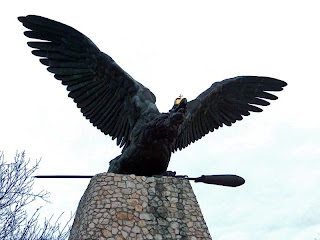
Who is this fine-looking raptor? He is a quebrantahuesos (literally, a breaker of bones), also known as a bearded vulture (Gypaetus barbatus, sometimes known as a Lammergeier, though Bartgeier may be a more accurate translation). There are increasingly fewer of his kind to be found.
The Bearded vulture is the only animal that feeds almost exclusively on bone (70-90%). In Crete, the shepherds call it the "Bone-eater", as they have watched the bird breaking bones in a very characteristic way, since the old times. The bird throws the larger bones from a height on to rocky slopes in order to break them, and immediately descends after them in a characteristic spiral way. If the bone does not break the first time, the method is repeated many times until the bone finally breaks. The bird then eats the bone pieces starting with the bone marrow. The smaller bones are swallowed whole, as the bird's gastric fluids are so strong that they can digest bone easily. This dietary habit seems odd, but once bones have been digested, they are a nutritious and easily storable type of food; in addition, the bird faces minimal competition for this type of food.
From the preceding paragraph, you might reasonably think that this particular raptor poses no threat to humans. You would be wrong. It was a quebrantahuesos who was directly responsible for the death of Aeschylus. With a little help from a tortoise.

This is a bust of Aeschylus. Witness the shiny bald cranium. According to the story, in ancient Greek times, when bearded vultures were more common than today, they had discovered that one way to get at the juicy meat inside a tortoise was to shatter the tortoise's shell by dropping it from a great height onto a suitably chosen stone below. Apparently, from a great height, the shiny cranium of a Greek playwright is easily confused with a suitable stone. ¡Tortoise away!
Aeschylus did not survive the impact*. Had he done so, the discovery of gravity might have come considerably earlier than it did.
(*Those spoilsports at snopes.com would like me to tell you that this is an urban legend, with no probable basis in fact. But what do they know?)

Some of my internet investigations suggest that the quebrantahuesos may be found on the coat-of-arms of Transylvania, despite the species' extinction in that region for several hundred years, but this may be a wicissitude. The bird in question may be a different type of raptor altogether, or may be of mythical origin (the so-called turul)
The plain people of Ireland: Why are you telling us this? Not that it isn't interesting, mind you.
The management: I came across the word quebrantahuesos in a newspaper article, and it wasn't in my big dictionary. This is what I found out during my internet researches to find out what it meant. A little learning never hurts, don't you think? And the tortoise aspect is a nice twist, to make the kind of little vignette that our readers enjoy.
The plain people of Ireland: Oh, fair enough so.
The management: Besides which, I just like the word "quebrantahuesos". Breaker of bones. It has a nice ring to it.
The plain people of Ireland: Vultures are scary hooers all the same though. With their beady little eyes. You wouldn't want to be stuck in Death Valley with a few of them fellows giving you the evil eye.






No comments:
Post a Comment